Introduction
In the competitive landscape of digital marketing, understanding the intricacies of Search Engine Optimization (SEO) is essential for clinic owners aiming to enhance their online visibility. SEO encompasses a range of strategies, including:
- Keyword research
- Building a robust backlink profile
All designed to improve a website’s ranking on search engines like Google. With the ever-evolving nature of search algorithms and user behavior, staying informed about best practices is crucial. This article delves into the core components of SEO, offering insights on:
- Creating high-quality content
- Leveraging local SEO through Google My Business
- Utilizing analytics tools to track performance
By mastering these elements, clinic owners can navigate the complexities of SEO and position their practices for success in an increasingly digital world.
Understanding the Basics of SEO for Google Promotion
Search Engine Optimization (SEO) is the strategic practice of improving a website’s visibility within engine results, specifically focusing on how to promote your site on Google. The essential elements of SEO include:
- Keyword research
- On-page optimization
- Involves factors such as meta tags and structure
- Off-page strategies
- Such as backlinking
Mastering these elements is essential for any clinic owner aiming to enhance rankings effectively.
It is crucial to stay informed about the search engine’s algorithms and updates, as these factors significantly influence how content is ranked. Notably, statistics reveal that 37% of businesses experience a decline in their rankings when searches are performed on mobile devices, underscoring the necessity of mobile optimization within SEO strategies. Resources like Search Central provide invaluable insights into best practices on how to promote your site on Google to enhance SEO performance.
Regarding the length of material, it is essential to mention that AI Overviews feature an average of 4,342 characters, which can affect visibility and engagement. As a result, clinic owners should consider the depth and comprehensiveness of their material. Furthermore, the recent trend suggests that average SEO agency rates exceed $100 per hour, with an average hourly charge of $134.66, highlighting the investment required to access professional SEO expertise.
According to the case study titled ‘AI Overviews in Search Engines,’ AI-generated material is still a small portion of overall search results, available for only 8.71% of keywords. Understanding these dynamics can empower clinic owners to navigate the complexities of SEO and understand how to promote your site on Google to enhance their online presence.
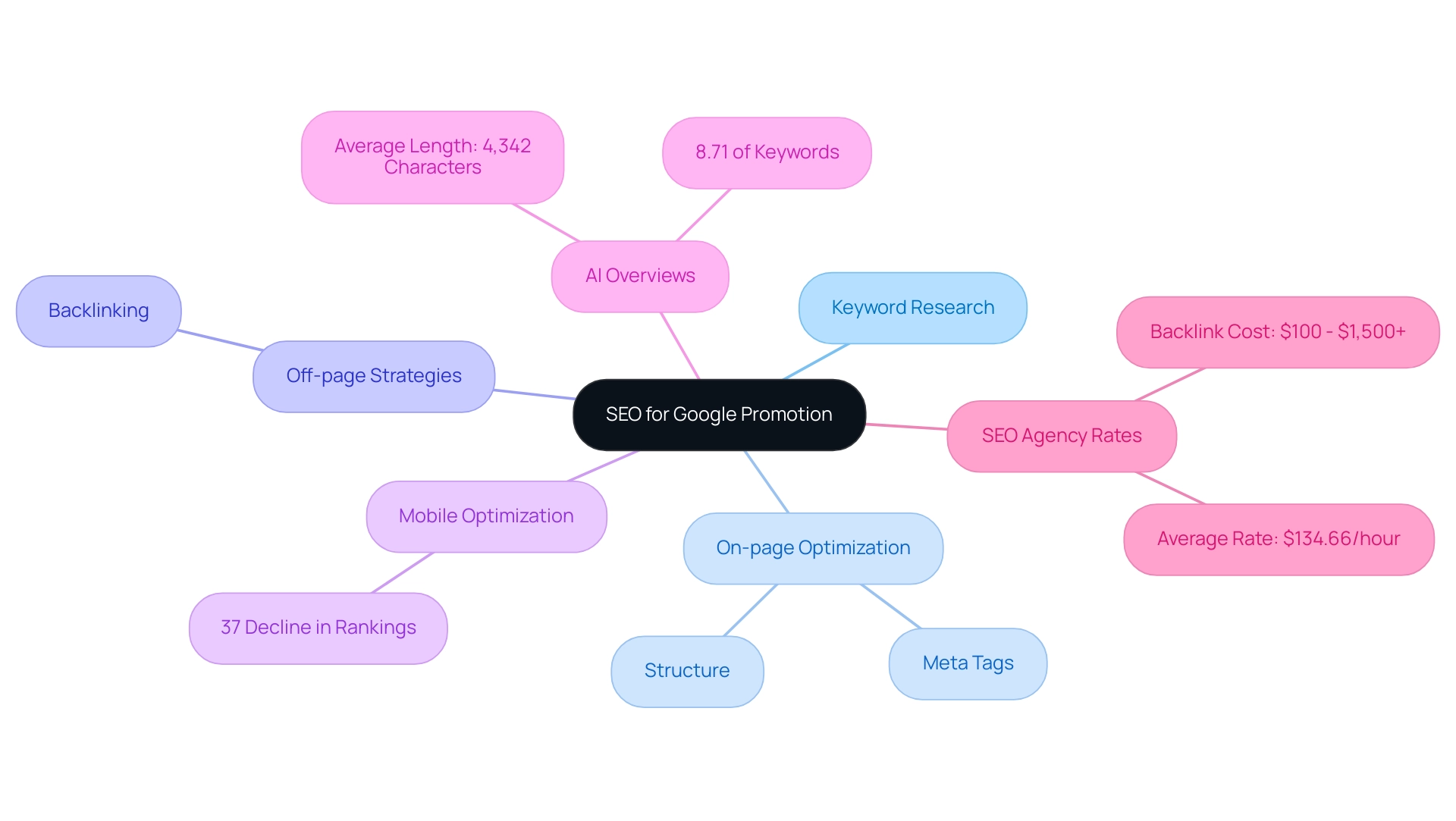
Creating High-Quality Content and Targeting Keywords
To produce high-quality material, it is essential to start with comprehensive keyword research utilizing tools such as Google Keyword Planner or SEMrush. Identifying keywords that potential patients are actively searching for is crucial, as this allows for their natural incorporation into your material. Strive to craft informative and engaging articles or blog posts that address prevalent questions and concerns within your specialty.
Proper structuring of material is vital; utilizing headings, bullet points, and images can significantly enhance readability. Furthermore, regularly refreshing your material ensures it remains relevant and accurate, which is instrumental in maintaining and improving your SEO rankings over time. According to industry insights, 84% of B2B marketers assert that material marketing significantly enhances brand visibility, underscoring the importance of high-quality material in the context of SEO.
Furthermore, it is significant that under 9.9% of SEO specialists and agencies charge more than $150 per hour, emphasizing the importance of high-quality production. The obstruction of AI crawlers by 48% of leading news websites suggests a resistance to AI technologies, highlighting the importance of preserving high-quality material to guarantee accessibility and engagement.
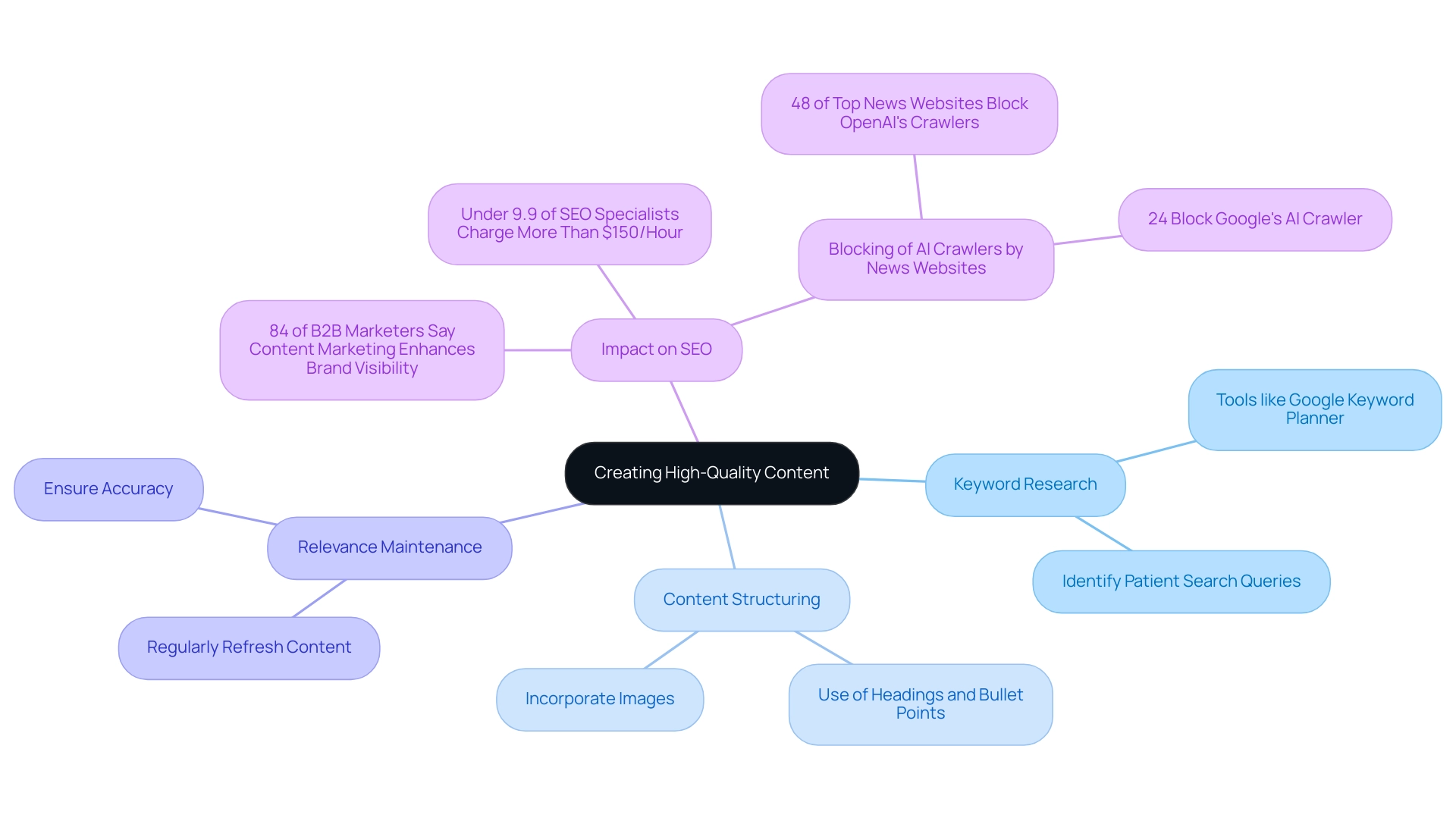
Building a Strong Backlink Profile for Enhanced Visibility
To establish a robust backlink profile, it is crucial to identify reputable websites within your industry and proactively seek guest posting opportunities with them. Effective guest posts not only enhance your site’s visibility but also drive traffic. Creating shareable materials—be it infographics, comprehensive research studies, or expert guides—can significantly enhance your chances of earning high-quality backlinks, as this type of work is more likely to be linked by others.
Notably, only 5.2% of link builders consider the presence of the ‘Write for us’ page a major red flag, underscoring the importance of choosing the right websites for guest posting. Additionally, forming partnerships with local businesses or organizations can create reciprocal linking opportunities, further enriching your backlink profile. Based on recent discoveries, an examination of 100,000 keywords shows that AI Overviews from the search engine are available for only 8.71% of keywords, highlighting the necessity for high-quality material that distinguishes itself.
Google AI Overviews typically contain an average of 4,342 characters, indicating the depth of content that may attract backlinks. It is also essential to continuously monitor your backlinks with tools such as Ahrefs or Moz, ensuring they remain relevant and of high quality. Steering clear of low-quality links is crucial, as they can greatly weaken your SEO efforts, affecting your overall visibility and rankings.
As noted in industry insights, SEOs typically invest 1-2 hours to build a single link, highlighting the time and effort necessary to cultivate an effective backlink strategy. Additionally, a case study on health and beauty purchases via smart speakers indicates a trend in consumer behavior that may relate to the effectiveness of online visibility strategies, particularly for clinic owners in the health and beauty sector. By following these best practices, you can learn how to promote your site on Google, significantly improving your website’s authority and engine performance.
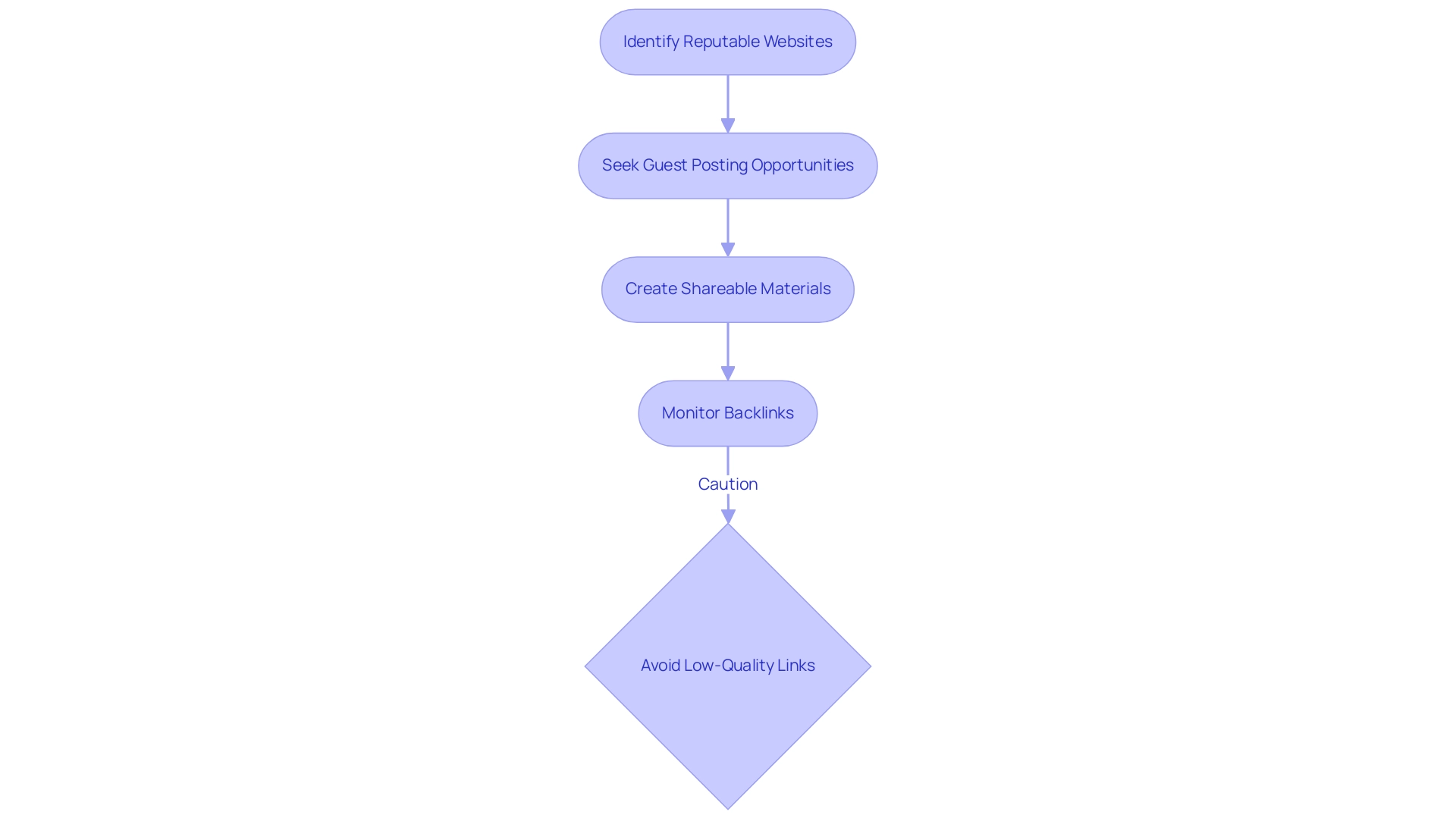
Leveraging Google My Business for Local SEO Success
The first step in understanding how to promote your site on Google is to claim and verify your Google My Business (GMB) listing. It is essential to ensure that your business name, address, phone number, and website are accurate and consistent across all digital platforms. This consistency not only improves your credibility but also aligns with current trends, as only about 64% of small businesses currently maintain an online presence, presenting growth opportunities for those lacking a website.
Moreover, the average local store posts 8.9 times per month on Facebook, highlighting the importance of regular engagement on social media platforms. High-quality images of your clinic should be uploaded to create an inviting online presence. Furthermore, motivating pleased patients to submit positive reviews can greatly influence your local visibility, as businesses with an average of 10 or more reviews often experience heightened engagement.
Regularly updating your GMB profile with posts about services, promotions, or events is a key strategy in learning how to promote your site on Google, as it keeps your audience informed and engaged. The Q&A feature is another valuable tool; actively addressing common patient inquiries can be part of how to promote your site on Google to enhance your visibility in local results. According to a report by Think with Alphabet, 60% of smartphone users have reached out to a business directly through results, emphasizing the effectiveness of such optimizations.
This statistic is supported by a case study showing that mobile search facilitates direct communication, as 60% of smartphone users utilize the ‘click to call’ option. In 2024, strategies that prioritize mobile-friendly sites will be essential, as 61% of mobile searchers are more likely to contact local businesses that provide a seamless mobile experience.
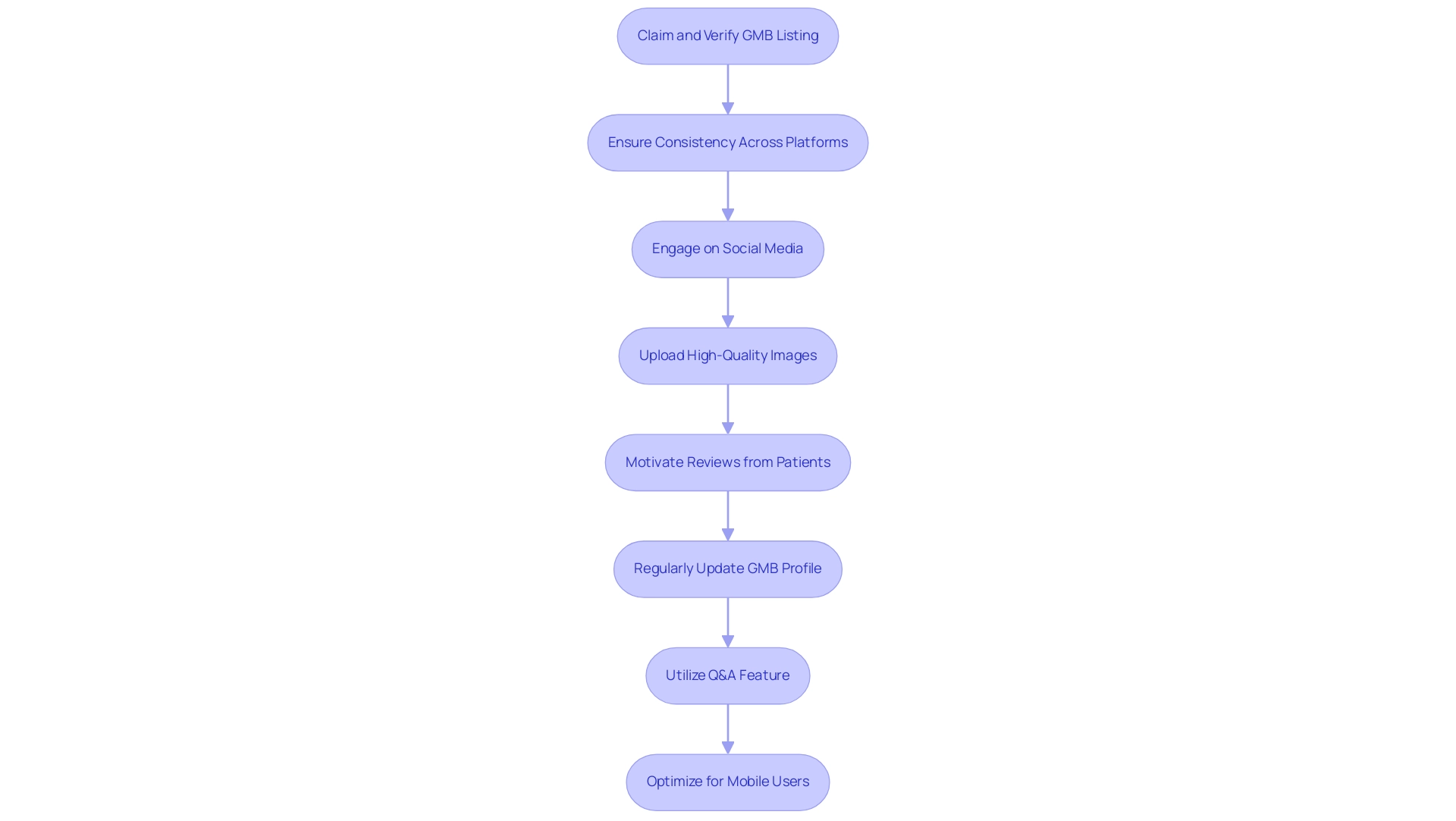
Tracking Performance with Analytics Tools
Employing analytics tools such as Google Analytics 4 and Google Search Console is crucial for monitoring website performance effectively, especially for new clinics that may have a Domain Authority (DA) score between 10-20. These platforms enable clinic owners to track essential metrics, including organic traffic, bounce rates, and conversion rates, which are vital indicators of SEO success. As Macy Storm, a Senior Content Creator, emphasizes, ‘Utilizing the right analytics tools can transform your understanding of online performance.’
By establishing specific goals and utilizing UTM parameters, you can assess the performance of individual marketing campaigns with precision. Regularly reviewing analytics data allows you to detect emerging trends, pinpoint areas that require improvement, and uncover new optimization opportunities. For instance, the case study on DashThis illustrates how integrating various SEO tools can help visualize and communicate SEO performance effectively, making it easier to explain results to clients or stakeholders.
A thorough understanding of user interactions with your website not only aids in refining your SEO strategies but also enhances your visibility, ultimately attracting more patients to your clinic.
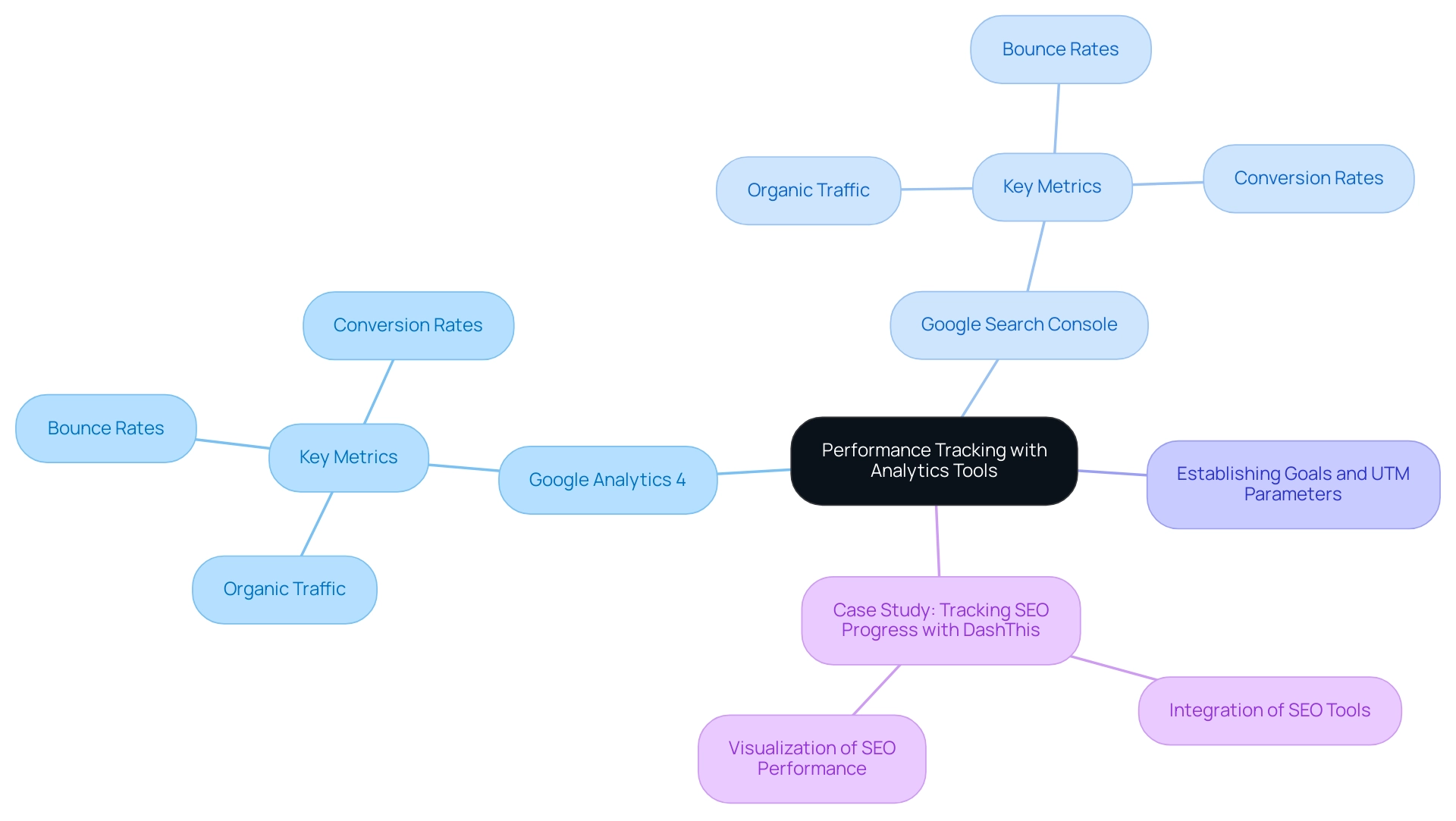
Conclusion
Understanding the multifaceted nature of SEO is vital for clinic owners aiming to boost their online presence. By focusing on core components such as:
- Keyword research
- On-page optimization
- Building a strong backlink profile
clinics can significantly enhance their visibility on search engines. High-quality content that addresses the needs and inquiries of potential patients remains a cornerstone of an effective SEO strategy. Regular updates and engaging formats can further improve user experience and search rankings.
Local SEO is equally important, and leveraging tools like Google My Business can create a strong local presence. Ensuring accurate business information and encouraging positive patient reviews can enhance credibility and visibility in local search results. Furthermore, consistent engagement through social media and regular updates on GMB can foster stronger connections with the community.
Finally, utilizing analytics tools to monitor performance is essential for understanding the effectiveness of SEO efforts. By tracking metrics such as organic traffic and conversion rates, clinic owners can make informed decisions, identify areas for improvement, and refine their strategies accordingly.
In navigating the complexities of SEO, clinic owners can position their practices for success in an increasingly digital landscape, ultimately attracting more patients and enhancing their overall business performance.

